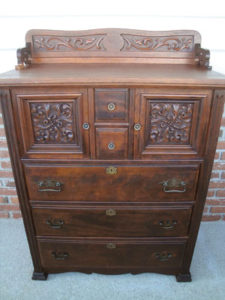
PK sent me photos of a fruitwood carved chest with three drawers towards the bottom and top section of two cabinets with wonderful carved surfaces. The two central drawers are square and small. PK looked for one like this to ascertain value and date of manufacture, but didn’t find anything online. PK didn’t find a similar one because we now consider this kind of dresser structure a white elephant. Why? The kind of apparel stored in such a dresser isn’t worn anymore, and hasn’t been worn from 1910 on. The two cabinets are for hats, the two little drawers alongside those cabinets are used, one for gloves, the other for collars.
The Detachable Collar
When a housewife in Troy, NY found the collar was the first thing on a shirt to become soiled she invented the detachable collar. To save washing the whole shirt she removed the collar. This enabled her to starch it separately as well. Her local pastor, the Rev. Ebenezer Brown, thought this a money making idea and opened a business. Troy, NY became the center of detachable collar manufacturing for years. One major export market for these collars became English Law Courts. The loose collars allowed the wearing of bands, those two strips of white fabric that denote judges, barristers and clergy in England.
Types of collars these drawers saw, PK, were the wing collar, for morning dress, and the imperial collar, a high collar with no wings, which went out of style with the Edwardian era (1901-10). Thus a dresser with a collar box, we know originates no later than 1910.
The hardware on your piece also points to the early 20th century. They represent Art Nouveau, the organic, delightfully fresh style of the turn of the last century. This style became very popular on the continent, but not used much in America, except on metalwork (think Tiffany). If you think of the great underground station entrances in Paris, you’ve seen Continental Art Nouveau.
Men who used this dresser wore hats
The English invented the Derby/Bowler, worn by the gamekeeper on an estate, as a branch couldn’t catch on it and knock it off. Other hats worn circa 1900 era include the Homburg or Hamburg, a felt hat with a short brim and a top crease, and the Boater, a straw hat with a grosgrain ribbon around the crown. This dresser held any of those in its cabinets.
The End of Hats and Collars
By the beginning of World War I, the glory days of men’s conservation fashion ended, along with hats and collars. If you purchased a suit, hat and collar, a gent turned to comfort over structure. Dressers like this one usually became retired to the attic or the junk wagon.
The drawer joints also indicate age and geographical location of the dresser. We expect to see dovetail joints on early dressers. Those joint, always handmade, were used from the late 1600’s to 1860. Then an industrious carpenter named Charles B. Knapp of Waterloo, WI invented a completely mechanized drawer joint. We call those little round pegs the scallop and dowel, the pin and scallop, or the half moon. In America the factories equipped with Knapp machinery were located in the Midwest and the East Coast. A factory produce 200 drawers a day, as opposed to making drawers to the tune of about 20 per day with a handmade dovetail joint.
When the US celebrated the Centennial in 1876, people didn’t considered those round pegs authentic enough for Early American, the craze in built furniture at the time. The Knapp joint fell out of fashion by 1900. So I date this dresser to 1900 again, by analyzing the construction. The piece might have been made in the great furniture center of America at the time, Grand Rapids, MI. The piece made to store hats and collars is worth about $800. Folks still can’t figure out HOW to use little collar drawers and hat cabinets today.